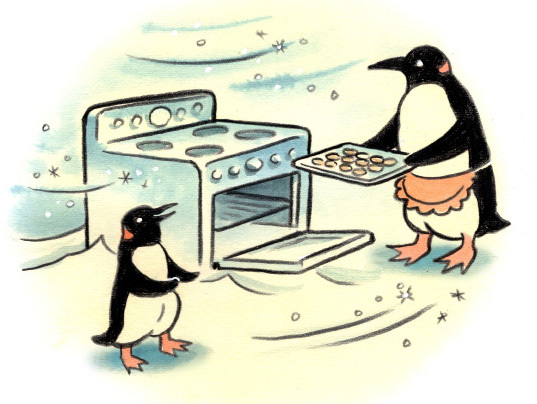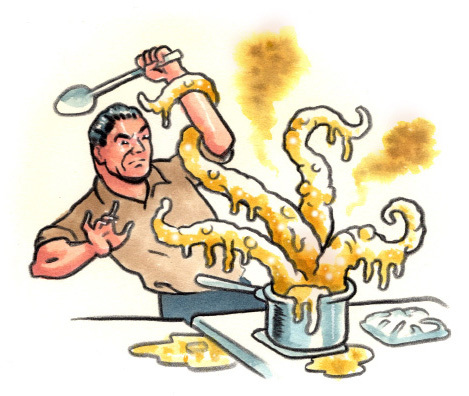
A Heated Debate
Jim Boyle, of Cheshire, Massachusetts, wonders whether it’s necessary to preheat an oven before cooking food in it. Would it be more efficient to simply put food in a cold oven and cook until it reaches the correct internal temperature?
There are various reasons ovens are heated to the desired temperature before food is placed in them. For one, an initial blast of heat is needed to jumpstart many reactions critical to a dish’s final texture and flavor. Sugars begin to caramelize at 338°F, while proteins begin to brown at 284°F. And unlike stovetop cooking, cooking in the oven relies on indirect heat—meaning that quite a bit of heat is required to ensure foods reach these temperatures. With baked goods, this immediate heat exposure also is crucial for so-called oven spring, a term used to describe the initial expansion of dough or batter in the oven. And it evaporates moisture in butter, creating a burst of steam that’s responsible for the flaky texture of pie crusts and biscuits. Most recipes are written to take advantage of these effects. Nonetheless, it is technically possible to bring foods to the correct internal temperature by starting them in a cold oven. But should you? To find out, we gave it a try. In our testing, we found that cold-start cookies baked unevenly (and required a lot of monitoring), while puff pastry turned out unpleasantly pasty. Meanwhile, root vegetables roasted in a heated oven got far better caramelization and softened more than those started in a cold oven. Similarly, a hot-start pork loin browned far better (and had better flavor) than a cold-start version. Interestingly, it took nearly the same amount of time for both roasts to reach the correct internal temperature, with the cold-start loin finishing mere minutes earlier than the hot-start loin did. In every case, we found that cooking in a cold oven sacrificed flavor, while being no more efficient.
The Golden Touch
Many recipes for sticky-sweet baked goods call for corn syrup. But our callers were curious whether golden syrup could be used as a substitute. And if so, does it make a difference in flavor?
Corn syrup is a sugary liquid derived from corn. Common in American baking, corn syrup’s hygroscopic nature (it draws in water) makes it a good choice for ensuring a moist texture. It also does not require additional dissolving the way granulated sugar does. (It is worth noting that corn syrup is not the same as high-fructose corn syrup, a more processed and controversial food additive.) Golden syrup, also known as “light treacle,” is a sweetener from the U.K. that often can be found in the baking aisle of American supermarkets. It is made by boiling sugar cane juice down to a thick, amber-colored syrup that tastes less sweet than corn syrup with a hint of caramel. To test whether it can be substituted for corn syrup, we used both to make pecan pies and marshmallows and were pleased with the results. Both pies were equally gooey, and the marshmallows were nearly identical—the golden syrup marshmallows were only slightly creamier. The biggest difference was in flavor. The versions made with golden syrup had toasty, caramel notes, while those made with corn syrup did not. Ultimately, we find the choice comes down primarily to taste preference.

Polenta Problems
New York City caller Bill Weiss asked for help with a polenta puzzle. When he cooks it on the stovetop, it turns into a runny, gluey mess. Because he likes to stir in cheese near the end of cooking, this raises an intriguing question: Could cheese be the culprit?
We doubt it. Cheese does contain amylase, an enzyme that can affect the sorts of starches present in polenta, but it is highly temperature sensitive. Above 160°F, the enzyme is deactivated, and polenta hot off the stove far exceeds that. Rather, we suspect the reason for the runny polenta is the cooking method. Though polenta seems simple to make—it’s nothing more than cornmeal cooked with water and salt—it can be tricky to master. In fact, there are many reasons it can turn runny, including adding too much liquid, undercooking it or insufficient stirring (as stirring helps the cornmeal absorb liquids while distributing starches). Luckily, fixing the problem is usually relatively straightforward. If your polenta is runny, you can try to thicken it by adding more cornmeal or by cooking it for longer. Of course, avoiding the problem from the start is best. For that, we use our preferred polenta cooking method—the oven. We find that baked for an hour in a Dutch oven with moderate heat, polenta turns out perfectly, requiring only a bit of initial stirring. This set-it-and-forget-it approach sidesteps the runny polenta problem entirely. Find our recipe at 177milkstreet.com/polenta.






